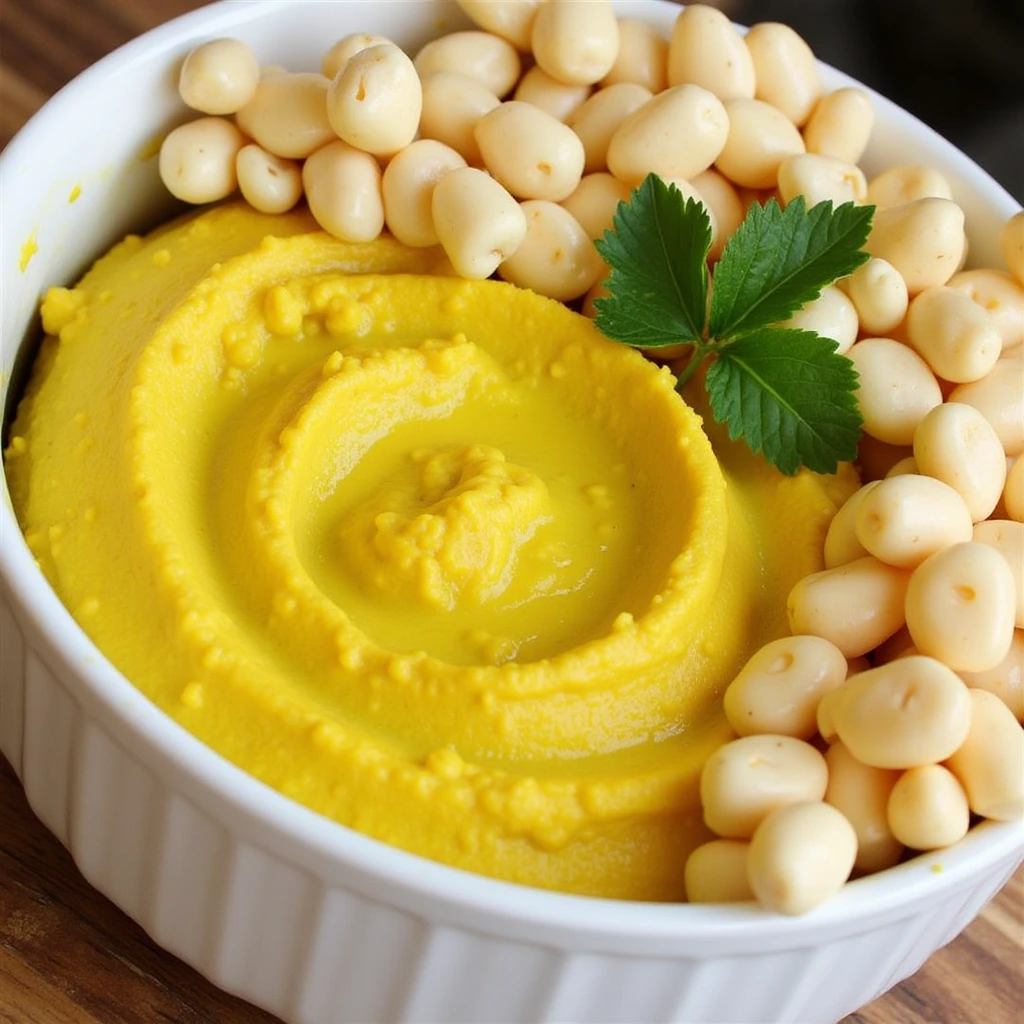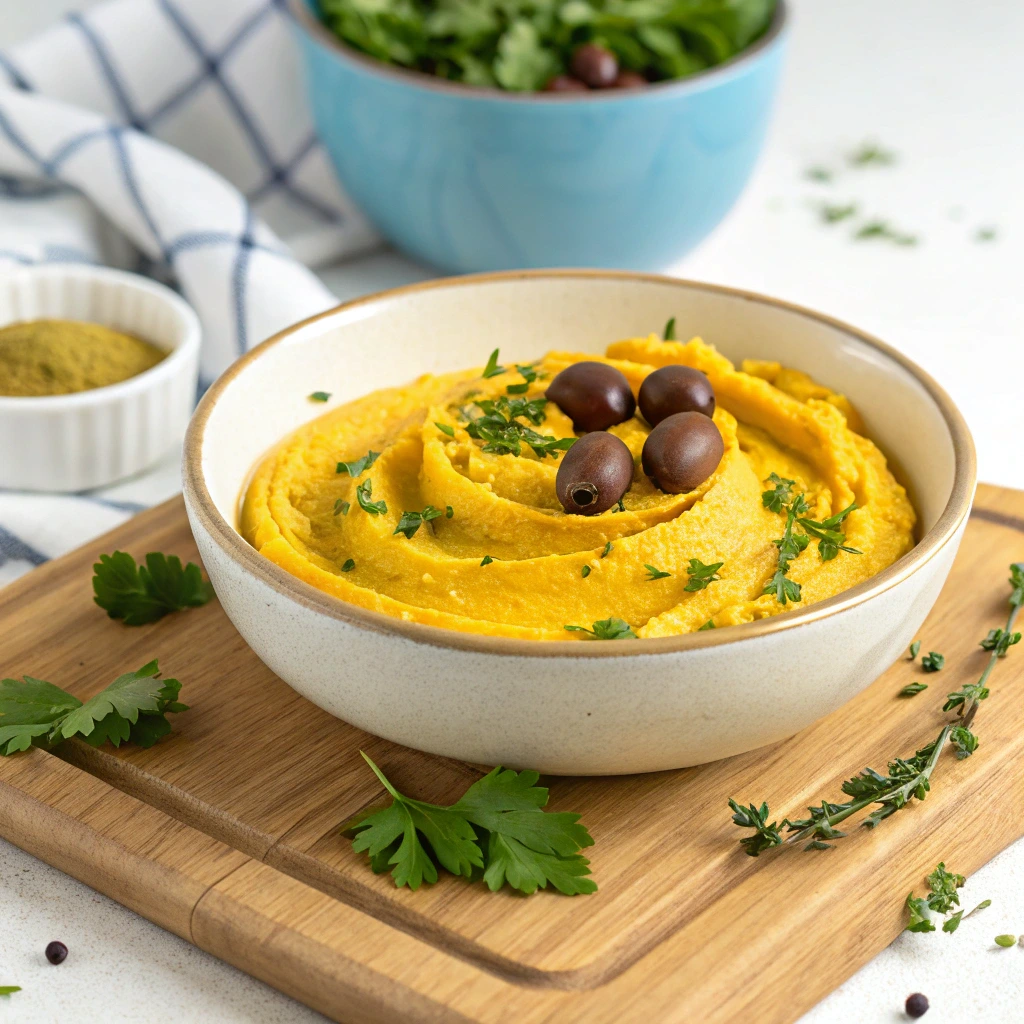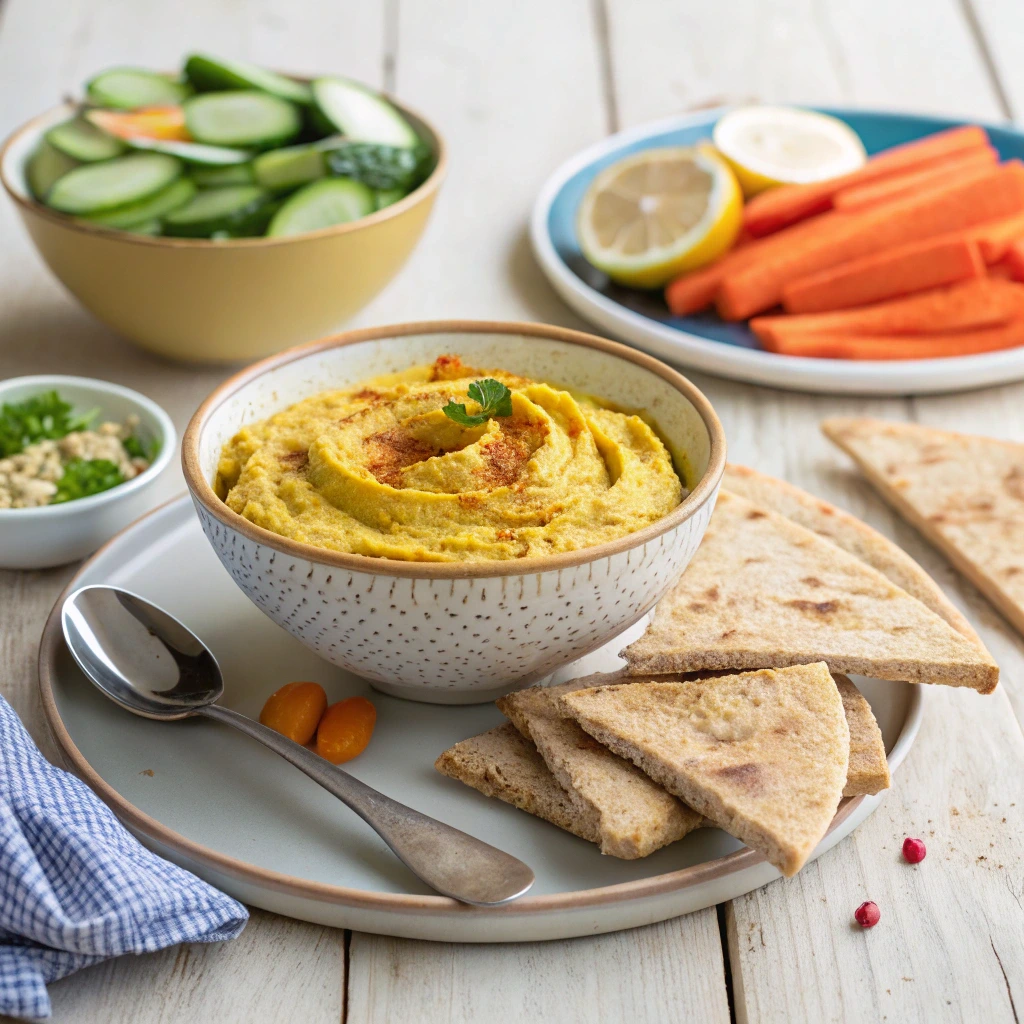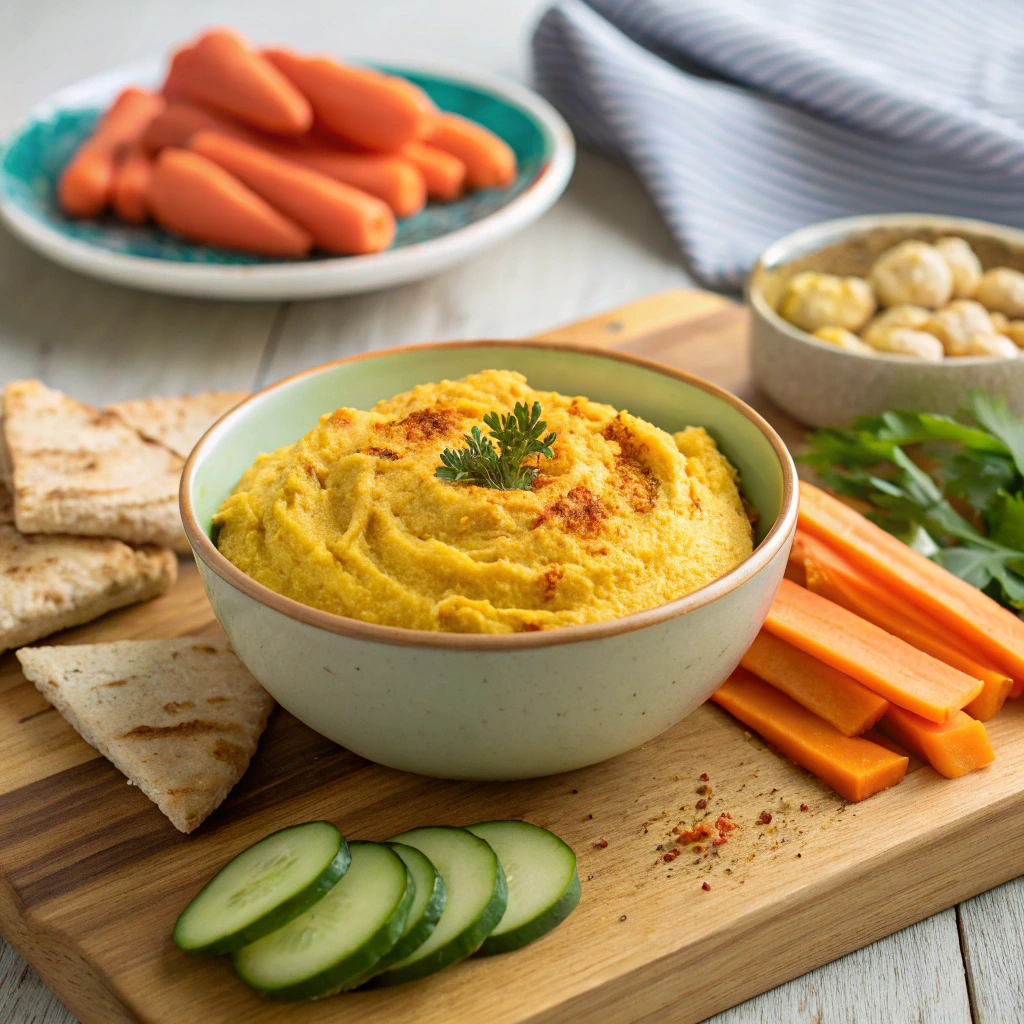
Introduction
Imagine walking into your kitchen, ready to create something that not only satisfies your taste buds but also nourishes your body. That’s exactly what turmeric hummus offers—a golden delight packed with flavor and health benefits. In recent years, this vibrant dip has gained immense popularity among food enthusiasts and health-conscious individuals alike. Why? Because it combines the creamy goodness of classic hummus with the powerful anti-inflammatory properties of turmeric.
If you’ve ever wanted to make turmeric hummus at home but weren’t sure where to start, don’t worry! This comprehensive guide will walk you through every step, from gathering ingredients to serving up a delicious batch. By the end, you’ll have a foolproof recipe for creating your own golden hummus—and maybe even impressing friends and family along the way.
Why Turmeric Hummus Is a Must-Try
Rich in Anti-Inflammatory Properties
Turmeric is more than just a spice; it’s a superfood powerhouse thanks to its active compound, curcumin. Studies show that curcumin can help reduce inflammation, making it an excellent addition to your diet if you suffer from conditions like arthritis or simply want to support overall wellness. Adding turmeric to your hummus transforms it into a nutrient-dense snack that does wonders for your body.
- Curcumin fights oxidative stress and reduces chronic inflammation.
- Regular consumption may improve joint health and boost immunity.
- Source: PubMed Study on Curcumin Benefits
A Vibrant and Flavorful Twist on Classic Hummus
Traditional hummus is already a fan favorite, but turmeric takes it to the next level by infusing it with a warm, earthy flavor and a striking golden hue. The result? A visually appealing dip that tastes as good as it looks. Plus, the mild spiciness of turmeric pairs beautifully with other ingredients like garlic and lemon juice.
- Compare the neutral tone of regular hummus to the boldness of turmeric-infused versions.
- Experiment with variations such as roasted garlic or smoked paprika for added depth.
Perfect for Health-Conscious Eaters
Whether you’re following a vegan, gluten-free, paleo, or keto lifestyle, turmeric hummus fits seamlessly into your dietary needs. Made primarily from chickpeas, tahini, and fresh herbs, this dip is naturally plant-based and free from common allergens. It’s also rich in fiber, protein, and healthy fats, making it a guilt-free snack option.
- Highlight how versatile turmeric hummus is for various diets.
- Mention its macro-nutrient profile: high in fiber, moderate in protein, and low in saturated fat.
Ingredients You’ll Need for Turmeric Hummus
To make turmeric hummus, you’ll need a handful of simple yet essential ingredients. Here’s a breakdown of what goes into this golden masterpiece:
Main Base: Chickpeas
Chickpeas form the foundation of any great hummus. They provide a creamy texture and are loaded with plant-based protein and fiber. For convenience, you can use either canned or dried chickpeas—just remember to rinse them thoroughly before blending.
- Canned chickpeas save time but may lack the nutty flavor of dried ones.
- Dried chickpeas require soaking overnight but yield a richer taste.
| Ingredient | Quantity |
|---|---|
| Chickpeas (cooked) | 1 cup |
Creamy Texture: Tahini and Olive Oil
Tahini, made from ground sesame seeds, adds silkiness and a subtle nuttiness to the mix. Pair it with extra virgin olive oil for a healthier alternative to processed oils.
- Use about 2 tablespoons of tahini for a standard batch.
- Add olive oil gradually while blending to achieve desired consistency.
| Ingredient | Quantity |
|---|---|
| Tahini | 2 tbsp |
| Olive Oil | 2 tbsp |
Zesty Flavors: Lemon Juice and Garlic
Lemon juice brightens the dish, balancing out the richness of tahini and chickpeas. Freshly minced garlic cloves add a pungent kick that ties everything together.
- Start with 1 tablespoon of freshly squeezed lemon juice and adjust according to preference.
- Roast garlic cloves for a sweeter, milder flavor.
| Ingredient | Quantity |
|---|---|
| Lemon Juice | 1 tbsp |
| Garlic Cloves | 1-2 |
Spices and Seasonings: Turmeric, Cumin, Salt, and Pepper
Of course, no turmeric hummus would be complete without the star ingredient itself! Ground turmeric lends both color and health benefits. Complement it with cumin for warmth and black pepper to enhance absorption of curcumin.
- Begin with ½ teaspoon of turmeric and increase based on taste.
- Add a pinch of cumin and freshly ground black pepper for complexity.
| Ingredient | Quantity |
|---|---|
| Turmeric | ½ tsp |
| Cumin | ¼ tsp |
| Salt | To taste |
| Black Pepper | To taste |

Step-by-Step Guide to Making Turmeric Hummus
Now that you know the ingredients, let’s dive into the process of making turmeric hummus. Follow these easy steps to ensure success every time.
Prepare Your Ingredients
Before starting, gather all your ingredients and measure them accurately. Rinse the chickpeas well and drain excess water. If using dried chickpeas, soak them overnight and cook until tender.
- Tip: Remove the skins of cooked chickpeas for smoother hummus.
- Optional: Toast spices lightly in a dry pan to release their aroma.
Blend Until Smooth
Transfer the prepared ingredients into a food processor or blender. Pulse in short bursts, gradually adding olive oil and water as needed. Continue blending until the mixture reaches your desired consistency.
- Blend for at least 2 minutes to ensure smoothness.
- Scrape down the sides periodically for even mixing.
Adjust Seasoning and Consistency
Once blended, taste the hummus and tweak the seasoning accordingly. Add more salt, pepper, or lemon juice if necessary. If the hummus feels too thick, thin it out with a splash of water or additional olive oil.
- Aim for a spreadable consistency—not too runny or stiff.
Serve Fresh and Enjoy
Garnish your finished turmeric hummus with a drizzle of olive oil, a sprinkle of paprika, or chopped parsley. Serve immediately with veggie sticks, whole-grain pita bread, or gluten-free crackers.
- Store leftovers in an airtight container in the fridge for up to 5 days.
Creative Ways to Enjoy Turmeric Hummus
Don’t limit yourself to traditional uses—turmeric hummus is incredibly versatile! Here are some creative ideas to incorporate it into your meals:
As a Dip for Veggies and Chips
Pair turmeric hummus with raw vegetables like carrots, bell peppers, and celery for a refreshing snack. Or serve it alongside baked tortilla chips for a crunchy treat.
- Suggest pairing options based on seasonal produce.
Spread on Sandwiches and Wraps
Replace mayonnaise with turmeric hummus for a healthier sandwich spread. Its tangy flavor complements grilled chicken, falafel, or avocado slices perfectly.
- Offer sandwich combinations featuring this dip.
Use as a Dressing for Salads
Thin out the hummus with water or apple cider vinegar to create a creamy salad dressing. Toss it over mixed greens, quinoa bowls, or roasted vegetables for added nutrition.
- Provide ratios for diluting hummus into dressings.
Innovative Recipe Ideas
Experiment further by incorporating turmeric hummus into unexpected dishes. Try it as a topping for baked potatoes, a filling for stuffed peppers, or even a base for homemade pizza.
- Encourage readers to share their unique creations.
The Science Behind Turmeric’s Health Benefits
Turmeric has been celebrated for centuries in traditional medicine systems like Ayurveda and Chinese medicine. Modern science now backs many of these ancient claims, revealing why turmeric is such a valuable addition to your diet.
Curcumin: The Powerhouse Compound
Curcumin, the active ingredient in turmeric, is responsible for its anti-inflammatory and antioxidant properties. Research shows that curcumin may help reduce inflammation markers in the body, potentially alleviating symptoms associated with conditions like arthritis, heart disease, and even certain cancers.
- Studies indicate that curcumin enhances brain function by boosting levels of Brain-Derived Neurotrophic Factor (BDNF).
- To maximize absorption, pair turmeric with black pepper, which contains piperine—a compound that increases curcumin bioavailability by up to 2000%.
Other Nutritional Highlights
Beyond curcumin, turmeric offers additional nutrients that contribute to overall health:
- Vitamins: Contains small amounts of vitamin C, vitamin E, and vitamin K.
- Minerals: Rich in iron, magnesium, and potassium.
- Antioxidants: Neutralizes free radicals, protecting cells from oxidative damage.
By incorporating turmeric hummus into your daily routine, you’re not just satisfying hunger—you’re nourishing your body from within.
Common Mistakes When Making Hummus (And How to Avoid Them)
Even experienced cooks sometimes encounter issues when making hummus. Below are some common pitfalls and solutions to ensure your turmeric hummus turns out perfectly every time.
Too Thick or Too Thin
One of the most frequent complaints about homemade hummus is inconsistency in texture. Here’s how to fix it:
- Too Thick: Gradually add water or olive oil while blending until the desired consistency is achieved.
- Too Thin: Add more chickpeas or tahini to thicken the mixture.
Overpowering Garlic Flavor
While garlic adds depth to hummus, too much of it can overpower other flavors. Roasting garlic cloves before adding them to the mix softens their sharpness and creates a sweeter profile.
- Tip: Use roasted garlic sparingly—start with one clove and adjust according to taste.
Not Enough Lemon Juice
Lemon juice balances the richness of tahini and chickpeas, so don’t skimp on it! If your hummus tastes bland, try adding an extra squeeze of fresh lemon juice.
- Always use freshly squeezed lemon juice instead of bottled varieties for better flavor.
Variations of Turmeric Hummus
Once you’ve mastered the basic recipe, feel free to experiment with different variations to keep things exciting. Here are a few ideas to get you started:
Spicy Turmeric Hummus
Add a kick of heat with red pepper flakes, cayenne powder, or diced jalapeños. If you’re looking for more ideas on spicing up your hummus, check out this article by Food52 for creative flavor combinations that will take your dip game to the next level.
Smoky Turmeric Hummus
Infuse your hummus with smokiness by adding smoked paprika or chipotle powder. It pairs beautifully with grilled vegetables or as a topping for tacos.
- Combine 1 teaspoon of smoked paprika with the standard recipe for a subtle smoky aroma.
Herbaceous Turmeric Hummus
For a fresher take, incorporate chopped herbs like parsley, cilantro, or dill. These additions lend brightness and complexity to the dish.
- Mix in 2 tablespoons of finely chopped herbs after blending for best results.
Storage Tips for Long-Lasting Hummus
Proper storage ensures your turmeric hummus stays fresh and flavorful for as long as possible. Follow these guidelines to extend its shelf life:
Refrigeration
Store leftover hummus in an airtight container in the refrigerator. Press plastic wrap directly onto the surface of the hummus to prevent oxidation, then seal the container tightly.
- Hummus keeps well for up to 5 days when stored properly.
Freezing
If you’ve made a large batch, consider freezing portions for future use. Transfer hummus into freezer-safe bags or containers, leaving some headspace for expansion.
- Frozen hummus lasts up to 3 months. Thaw overnight in the fridge before using.
Signs of Spoilage
Before consuming stored hummus, check for signs of spoilage such as mold, off odors, or unusual textures. Discard immediately if any are present.

Incorporating Turmeric Hummus Into Your Diet
Turmeric hummus isn’t just a snack—it’s a versatile ingredient that can elevate countless dishes. Here are some meal ideas to inspire you:
Breakfast Boost
Spread turmeric hummus on whole-grain toast and top with avocado slices, poached eggs, or cherry tomatoes for a nutritious breakfast.
Lunchtime Delight
Use it as a spread for wraps, sandwiches, or flatbreads. Pair with roasted veggies, falafel, or grilled chicken for a satisfying lunch.
Dinner Accompaniment
Serve turmeric hummus alongside roasted potatoes, quinoa salads, or grain bowls for a wholesome dinner option.
Dessert Twist
Believe it or not, turmeric hummus can even make its way into desserts! Blend it into smoothies, cake batters, or frosting recipes for a unique twist.
FAQs About Making Turmeric Hummus
Q: Can I Substitute Tahini?
Yes, you can substitute tahini with almond butter, yogurt, or cashew cream depending on availability and dietary preferences. However, keep in mind that each substitution will alter the flavor slightly.
Q: How Long Does Turmeric Hummus Last?
Stored properly in the refrigerator, turmeric hummus remains fresh for up to five days. Always check for signs of spoilage before consuming.
Q: Is This Recipe Vegan?
Absolutely! Since turmeric hummus relies solely on plant-based ingredients, it’s fully vegan-friendly. Ensure all substitutes used (like yogurt) are also vegan.
Q: What If I Don’t Have Fresh Garlic?
No problem! Powdered garlic works as a convenient alternative. Alternatively, skip it altogether if you prefer a milder taste.
Conclusion
Making turmeric hummus at home is easier than you think, and the rewards far outweigh the effort. Not only do you get to enjoy a nutritious and flavorful dip, but you also gain control over the quality of ingredients used. Whether you’re dipping veggies, spreading it on sandwiches, or experimenting with new recipes, turmeric hummus promises endless possibilities.
So why wait? Gather your tools, follow the steps outlined above, and embark on a culinary journey filled with golden delights. Once you’ve tried this recipe, we’d love to hear your thoughts. Share your experience in the comments below and explore our other articles for more inspiration!
Final Thoughts on Golden Delights
Turmeric hummus represents the perfect intersection of flavor, nutrition, and convenience. Whether you’re whipping up a quick snack or preparing a gourmet feast, this golden dip has something to offer everyone. By following the tips and tricks outlined in this article, you’ll be able to craft delicious batches of turmeric hummus that cater to your personal preferences and dietary needs.
So go ahead, embrace the magic of turmeric, and let your culinary creativity shine. Remember, cooking is all about experimentation and enjoyment—and turmeric hummus gives you the freedom to do both.

Final Call-to-Action
Your journey with turmeric hummus doesn’t end here. Keep exploring new recipes, sharing your creations, and inspiring others to join the golden revolution. Together, we can create a community centered around healthy, flavorful, and innovative eating.
What’s next? Try another one of our featured recipes or leave a comment below telling us what you’d like to see next. The possibilities are endless, and the only limit is your imagination. Stay curious, stay adventurous, and above all—stay golden!
